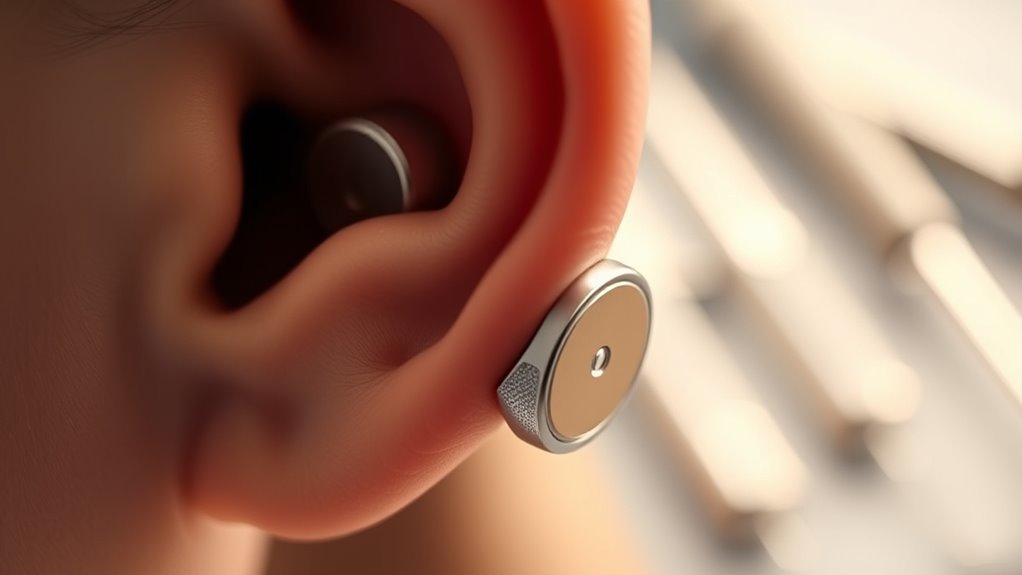Bone-anchored hearing systems are surgically attached devices that transmit sound directly to your inner ear through bone conduction, helping those with conductive or mixed hearing loss who can’t use traditional hearing aids. They use biocompatible titanium implants that bond securely with your bone, offering improved stability and quicker healing thanks to advanced materials and surgical techniques. If you’re curious about how these systems work and what recent innovations are making them better, keep exploring to learn more.
Key Takeaways
- Bone-anchored hearing systems directly transmit sound via bone conduction, bypassing damaged outer or middle ear structures.
- Titanium implants are preferred for their biocompatibility, durability, and ability to promote osseointegration.
- Minimally invasive surgical techniques reduce tissue trauma, scarring, and recovery time for implant placement.
- Advances include immediate loading, improved implant design, and the use of robotics for precise placement.
- These systems are effective solutions for conductive or mixed hearing loss unresponsive to traditional hearing aids.

Bone-anchored hearing systems offer an effective solution for individuals with conductive or mixed hearing loss who can’t benefit from traditional hearing aids. These systems bypass the damaged parts of the ear, transmitting sound directly to your inner ear through bone conduction. When considering this option, understanding the significance of implant material selection and recent surgical technique advancements can make a significant difference in your overall experience and outcomes.
Choosing the right implant material is essential for durability, biocompatibility, and long-term success. Titanium remains the most common material used because of its proven compatibility with human tissue, strength, and resistance to corrosion. Its ability to integrate seamlessly with bone helps secure the implant firmly, reducing the risk of loosening over time. Recent developments in implant materials have focused on surface modifications that promote faster osseointegration, meaning the bone bonds more quickly and securely with the implant. These improvements can lead to shorter healing periods and enhanced stability, ultimately offering you a more reliable and comfortable hearing solution.
Surgical technique advancements have also played a critical role in improving outcomes for bone-anchored systems. Traditional methods involved more invasive procedures, often requiring extensive tissue removal and longer recovery times. Today, minimally invasive techniques, such as punch or linear incision methods, are more common. These approaches reduce surgical trauma, minimize scarring, and promote faster healing. Surgeons now utilize precise imaging and computer-assisted planning to optimize implant placement, ensuring better alignment and stability. This precision not only lowers the risk of complications but also enhances the overall performance of your system.
Furthermore, recent innovations include the development of less invasive abutments and implants designed for easier placement. Some techniques now allow for immediate loading of the implant, meaning you can start using your hearing system sooner after surgery. Additionally, advancements in robotics and automation are beginning to influence surgical procedures, offering even greater precision and consistency. These advancements aim to make the entire process more comfortable and efficient, decreasing downtime and improving your confidence in the procedure.
Frequently Asked Questions
How Long Does It Take to Recover After Implantation?
Recovery after implantation typically takes about 1 to 2 weeks for the initial healing timeline, but full healing can take several months. Factors influencing your recovery include your age, overall health, and adherence to post-surgery care. You might experience some discomfort or swelling initially, but most people return to normal activities within a few days. Follow your doctor’s instructions closely to guarantee a smooth healing process and ideal results.
Are Bone-Anchored Hearing Systems Suitable for Children?
Yes, bone-anchored hearing systems are suitable for children, especially those with pediatric candidacy who have conductive or mixed hearing loss. You should consider growth considerations, as the device can be adjusted or replaced as your child’s skull develops. Consult with an audiologist or ENT specialist to guarantee the system fits well and meets your child’s needs, providing effective hearing improvement throughout their growth stages.
What Are the Maintenance Requirements for These Systems?
Think of your bone-anchored hearing system as a delicate garden needing care. You should follow simple cleaning routines, gently removing debris and ensuring the implant stays clear. Regularly check and manage the batteries, replacing them when needed to keep the system singing. By staying attentive to these maintenance tasks, you’ll keep your device working smoothly, providing clear sound and comfort, like nurturing a precious bloom that brightens your everyday life.
Can the Systems Be Used During Sports or Physical Activities?
Yes, you can wear your bone-anchored hearing system during sports or physical activities, thanks to its water resistance. However, it’s important to follow sports safety guidelines to prevent damage. Avoid swimming or submerging the device unless it’s specifically designed for water. Always verify your system’s water resistance level and take precautions like securing the device properly to ensure it stays safe during active movements.
What Are the Options if the Implant Fails or Causes Complications?
If your implant fails or causes complications, you can explore alternative treatments like hearing aids or cochlear implants. Sometimes, revision surgery is necessary to fix or replace the implant, restoring function and comfort. Think of it as updating your gear—just like switching sports equipment when needed. Consulting your audiologist promptly guarantees you get personalized guidance and effective solutions, so you stay connected with clear hearing and confidence.
Conclusion
By now, you see how bone-anchored hearing systems can dramatically improve your quality of life. These devices bypass traditional hearing pathways, offering clearer sound, especially for those with conductive or mixed hearing loss. Remarkably, studies show that over 90% of users report satisfaction after implantation. With such high success rates, it’s clear these systems aren’t just innovative—they’re transformative, giving you a better chance to reconnect with the world around you.











